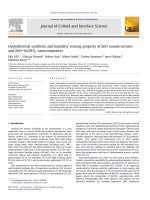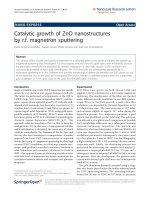Changing the shape of ZnO nanostructures by controlling Zn vapor release
Bạn đang xem bản rút gọn của tài liệu. Xem và tải ngay bản đầy đủ của tài liệu tại đây (869.94 KB, 3 trang )
<span class='text_page_counter'>(1)</span><div class='page_container' data-page=1>
VNU. JOURNAL OF SCIENCE. Mathem atics - Physics. T .xx. N03AP, 2004
<b>CHANGING THE SHAPE OF ZnO NANOSTRUCTURES </b>
<b>BY CONTROLLING Zn VAPOR RELEASE</b>
<b>T a D in h C a n h , T ra n T hi Q uyn h H oa, D ao Q u a n g D u y ,</b>
<b>N g u y e n V ie t T u y e n , N g u y en Q u a n g H oa, N g u y e n N g o e L ong</b>
<i>D epartm ent o f Physics, College o f Science, V N U</i>
Abstract. Our fabrication of ZnO nanostructures was based on a thermal
evaporation process of ZnO powder without the presence of a catalyst. The
source material was pure ZnO powder mixed with different contents of graphite
(molar ratio 1:1.2: 1:1.1: 1:1; 1:0.8, respectively). Temperature is the critical
experimental parameter for the formation of different morphologies of ZnO
nanostructures, Zn or Zn suboxide plays a crucial role for the nucléation of ZnO
nanostructures. The structure of the deposited materials was investigated by
X-ray diffraction, scanning electron microscopy. Photoluminescence measurements
were performed.
<b>1. In tr o d u c tio n</b>
Z n O n a n o s tru c lu re s are very p rom isin g fo r ap p lica tion s in fie ld e m ission displays
<b>and photonic devices operating in blue and u v spectral ranges due to its wide band gap </b>
(3.37 eV) a n d large exciton b in d in g energy (60 m eV) [1], Th erefore, fa b rica tio n and
properties o f Z n O n a n o stru ctu res have attracted considerable a tte ntion re ce n tly [2,3],
In th is w ork, we fa b rica te d Z n O nanow ires from a m ixtu re o f Z n O a n d carbon in
order to in ve stig a te the change in the shape o f obtained stru ctu re s by v a r y in g the release
<b>rate of Zn vapor.</b>
<b>2. E x p e rim e n ts</b>
<b>ZnO nanowires array was fabricated by a thermal evaporation process of the ZnO - c </b>
pow der mixture. The mixture of zinc oxide and graphite powders was loaded in a quartz
boat and placed in the cen te r o f a h orizo nta l q u a rtz tube furnace, w h e re the tem perature,
<b>pressure and evaporation time were controlled. The thermal evaporation of the ZnO + c </b>
<b>powder source was performed at 1000 UC for 1 h under an argon flow with the rate of 500 </b>
stan d ard cub ic cen tim e te rs per m inu te (seem) m a ita in in g a con stan t pressure o f 0.2 atm in
the fu rn a ce cham ber. S evera l cleaned s ilico n substra tes w ere placed in sequence a t the
dow nstream in the q u a rtz tube fo r collection o f the products.
T h e as-synthesized products were chara cterized by X -ray d iffra c tio n (X R D ) (Siemens
<b>D505 with Cu K„ radiation), Scanning electron microscope (SEM) (JSM 5410 LV) for the </b>
ana lysis o f the m icrostru ctu re . Photolum inescence m easurem ents w e re perform ed by using
<b>a FL 3 - 22 spectrometer with a Xenon lamp as the excitation source at room temperature.</b>
</div>
<span class='text_page_counter'>(2)</span><div class='page_container' data-page=2>
3 0
<i>Ta Dinh Canh, Tran Thi Quynh Hoa...</i>
<b>3. R e su lts an d d is c u s s io n</b>
<b>?ĩ beta-Scale</b>
<b>Fig.l. XRD patterns of the as - made ZnO </b>
<b>nanowires with different ratio of ZnO</b>
(a ) X = 0 .8 : (b) X = 1.0: (c) X = 1.1; (d) <i>X</i> = 1.2
F ig . l show s th e X R D p a tte rn s o f as
synthesized Z nO n a n o w ire s w ith th e source
m aterial w ith d iffe re n t con te n ts o f g raph ite
(m olar ra tio s o f p u re Z n O a n d g ra p h ite are
x = 0.8. 1.0, 1.1 a n d 1.2, respectively).
<b>The crystallinity of the ZnO nanowires, </b>
<b>the existence of zinc flakes in the as-made </b>
<b>sample as X = 0.8 and </b>1.0 w e re studied by X -
<b>ray diffraction. From these spectra, it is found </b>
<b>that both samples with X = 0.8 and 1.0 show a </b>
<b>typical wurtzite hexagonal structure like bulk </b>
<b>ZnO with unitcell constants of a = 3.248 Â and </b>
c = 5.206 Â.
A re p resentative energy dispersive X-ray
(ED S) spectrum o f the n a no w ire s is d epicted in F ig .2.
O n ly the peaks associated w ith Zn and o atoms are
seen in the E D S spectrum , le a d in g to the obvious fact
th a t the n anow ires a re in de e d Z n O m aterial.
T h e S E M im ages in Fig .3 e x h ib it the side view
o f d iffe re nt shapes o f Z n O n a no w ire s grown on a Si
substrate in the tem p era tu re range (650-500°C).
T h ese im ages show th a t th e n a n o w ire s are grown not
from the Si substra te b ut from a th ick layer o f Z nO
p oly crystallin e m a te ria l on the top o f the Si
substrates, in d ic a tin g that the th ick la ve r is formed before th e fo rm a tio n o f the nanowires.
<b>Fig.2. The EDS spectrum of the ZnO</b>
<b>Fig.3. The side view images of the material grown on Si substrate: </b>
temperature range (650 - 500 oC) with different ratio of ZnO and carbon powder
(a) X = 1.2; (b) X = 1.1 ; (c) X = 1.0; <d) X = 0 .8
</div>
<span class='text_page_counter'>(3)</span><div class='page_container' data-page=3>
<i>Changing the shape of ZnO nanostructures by...</i>
31Wave length (nm)
Fig.4. The P L E spectra o f ZnO nanowires
on Si subtrates with different contents of <b>c </b>
<b>(a) X = 0.8; (b) X = 1.0; (c) X = 1.1; (d) X = 1.2</b>
ZnO + <b>c </b> -» Zn + CO,
<b>ZnO + CO —> Zn + CO2 .</b>
<b>Zn vapor should condense on the iner </b>
<b>wall on the quartz tube forming liquid</b>
<b>droplets, which are </b> <b>ideal nuclei o f ZnO</b>
<b>nanowires for the vapor-liquid-solid (VLS) </b>
<b>reaction [1]. (Fig.3, a, b).</b>
<b>Figure 4 presents photoluminescence </b>
<b>excitation (PLE) spectra o f nanowires with </b>
<b>different ratio of ZnO and c powder on Si </b>
<b>su bstrates for th e green em ission monitored </b>
<b>at 500nm. The peak of excitation spectra appears at 371nm (= 3.34 eV) approximated to </b>
<b>the energy band edge.</b>
<b>Photolum inescence </b> <b>spectra </b> <b>o f ZnO </b> <b>2E*007,,— </b>
<b>-nanowires </b> <b>a t </b> <b>room </b> <b>tem perature </b> <b>were </b> <b><sub>16E*007- </sub></b> <b>i<sub>g</sub></b>
<b>measured and shown in F ig .5. A weak </b>u v <b>- </b> <b>*</b>
<b>band a t 380 nm and a strong green band at </b>
<b>500 nm w ere detected from all ZnO products.</b>
<b>The u v band em ission o f ZnO, maybe, has </b>
<b>been understood to be related to the exciton </b>
<b>em ission, w h ile </b> <b>th e m echanism of green</b>
<b>em ission has been su g g ested mainly due to </b>
<b>th e present o f various point defects, either </b>
<b>extrinsic or intrinsic, which can easily form </b>
<b>recombination centers.</b>
<b>Wavelength (nm)</b>
Fig .5. Room temperature P L spectra of ZnO
nanowires with different contents of carbon
( a ) X = 0.8 ; (b) X = 1.0; (c) X = 1.1; (d) X = 1.2
<b>4. C o n clu sio n s</b>
<b>U sin g zinc oxide and graphite powders a s source m aterials, ZnO nanowires were </b>
<b>farbicated on Si su b stra tes at low tem peratures. The growth process w as attributed to a </b>
<b>VLS m echanism. The ZnO nanowires exhibit an em ission at </b>u v <b>and green region.</b>
<i><b>A cknow ledgem ents. T his work is supported by Natural Science Council o f VN under </b></i>
<b>code No 811304. The authors would like to thank th e Center for Material Science, </b>
<b>Faculty of Physics, U n iversity of Science • VNU for help us in experim ents.</b>
<b>R e fer en ces</b>
<b>1. </b> <i><b>Y.u.Leung, A.B.Djurisic, J.Gao. M.H.Xie, W.K.Chan, Chermical Physics leters, </b></i>
<b>385(2004). 155-159.</b>
<i><b>2. J.S.Lee, K.s.Park, M.I.Kang, I.w.Park, S.W..Kim, W.K.Cho, H.S.Han, s.Kim , Journal </b></i>
<i><b>o f crystal grow th, 254(2003), 423-431.</b></i>
</div>
<!--links-->









